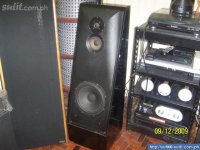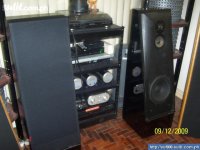Also I've never heard one, so it would not be good if I built it and didn't like it.
In one thread some one called it harsh, then some one else called it harsh, but maybe just forwardness that sounded like harshness to increased power response, perhaps, I forget. And then one guy said he couldn't make the tweeter "'disappear'".
Its tiring dealing with generalities made by people who heard various horns and makes blanket statements about how they all sound. They all sound different just like all tweeters sound different. The guy making the 'harsh' statement didnt use an XT25, didnt use Dave's WG (just like tweeters, each sounds different), and its not established what he used it in, how it was crossed, ect. Zaph's WG wont sound like the one I used, none will.
I fail to see why when some uses a great combo and has first hand info, that people credit people who don't have it. I have it, he doesn't, but you make a decision based on the guy who doesn't have it?
Horns aren't nec WG's. Some types of horns exaggerate some freq at some axis. WG's dont. The graph you posted up there from my post shows the off axis getting bad at 90 degrees. That's hardly a fair statement since at 90 degrees the bare tweeter will fall off the map altogether.
I've bought and sold in this forum, about 12 pairs of tweeters. I disliked all but two. Does that mean the others were all bad sounding?
Last edited:
I like the waveguide idea, but unfortunately the boost a tweeter gets at one listening position from a waveguide comes from the off-axis SPL drop, which exactly what I want to avoid.
Your statement shows you arent getting the idea and that a WG with a cap should be a flat line.
Last edited:
I won't be using a waveguide, since there is no room.
I'm putting some drivers in an old Thiel CS3.5 and running it active off of my computer:
Use the DXT from Seas. It got the best off axis bare from a small WG that fits in the standard 104mm tweeter opening. Zaph loves it and was blown away by its off axis response. Its perfect for your 2K application.
The Madisound Speaker Store
Use the DXT from Seas. It got the best off axis bare from a small WG that fits in the standard 104mm tweeter opening. Zaph loves it and was blown away by its off axis response. Its perfect for your 2K application.
The Madisound Speaker Store
Yeah, I was thinking of that tweeter too.
I just checked the FR graph of that tweeter. It's like your bigger waveguides but not as bad for my application. Probably because it's a smaller waveguide.
Very generally, I was stating that energy is conserved.
"There's no such thing as a free lunch".
Waveguides don't create energy. And there is no energy input into a waveguide itself.
Waveguides transfer energy from one place to another (off-axis to on axis).
All your graphs show this.

With wave guide

If anything, I would want the acoustic energy to be transfer in the opposite direction.
If I wanted a waveguide, just off hand (guessing), I would say it would need to be in front of the tweeter and be the negative image of your waveguide.
Last edited:
Hi,
The manual is very badly written. Any amplifier that can operate with
3 bridged channels into 8 ohms for a total of 3 x 120W into 8 ohms
can operate as a 6 channel amplifier giving 6 x 60W into 4 ohms.
The specification is simply wrong. Each channel is likely about 45W into 8 ohm
and 60 W into 4 ohm to give 120W 2 channels bridged into 8 ohms only.
The 4 ohm tweeter will be fine. A DC blocking capacitor is a good idea.
rgds, sreten.
The manual is very badly written. Any amplifier that can operate with
3 bridged channels into 8 ohms for a total of 3 x 120W into 8 ohms
can operate as a 6 channel amplifier giving 6 x 60W into 4 ohms.
The specification is simply wrong. Each channel is likely about 45W into 8 ohm
and 60 W into 4 ohm to give 120W 2 channels bridged into 8 ohms only.
The 4 ohm tweeter will be fine. A DC blocking capacitor is a good idea.
rgds, sreten.
Waveguides transfer energy from one place to another (off-axis to on axis).
All your graphs show this.
If anything, I would want the acoustic energy to be transfer in the opposite direction.
If I wanted a waveguide, just off hand (guessing), I would say it would need to be in front of the tweeter and be the negative image of your waveguide.
You are using a poor wave guide example to illustrate a false statement. The drop in the top end on that graph is a bad example. There is no drop off like that with Dave's WG. That is Zaph's WG using a tweeter that is a dome and didnt mate well to the given WG. I used that graph to show the low end boost and how a cap counters it and to illustrate what happens to distortion but its a bad example for top end integration
WG's do not move energy from top to bottom.
Now for a good example of a WG this is a scan speak dome tweeter bare. The top blue line is 0 degrees and averages -17db:

Here is that same dome tweeter in Dave's 7x5 WG. There is no top octave drop off even way off axis and the high frequencies you keep thinking are worse with a WG are actually boosted averaging -12db, a 5db boost . Saying you get bottom octave at the expense of top end loss is 100% false. Look at the 3 bottom lines. The blue, 3rd from the bottom is at -50db on the above graph. Look at the same line on the next graph. The wave guide has that same line at -35. The WG boosted the 50 degree off axis 15db at 20K and the on axis is higher than bare too. Compare the bottom green lines. Staggering.

You DONT want the top end boosted more than the bottom octaves. Saying you want a rising top end shows you dont understand what the capacitor + WG do to low end distortion. You need the rising low end to have a cap counter the rise and lower distortion. The cap is suppressing 500 and 1000hz 20db. 500hz is what F3 distortion at 2000hz is based on. 1000hz is what F2 at 2000hz is based on. How would a cap lower the distortion at 2000hz if you had a higher top end than low end? You couldnt use a cap to counter the rise.
Last edited:
Your statement shows you arent getting the idea and that a WG with a cap should be a flat line.
Your statements show you aren't getting the idea of physics.
Waveguides transfer energy they don't create it.
The tweeter creates 100% of the energy.
The waveguides you're referring to, deflect the radiation pattern (or guide the wave
The Waveguides you are referring to transfer energy to a place my head won't be, there will be a wall there. The energy you are transferring to the wall I want going to my ear canals. Do you understand?

Saying you get bottom octave at the expense of top end loss is 100% false.
Where did I write that?
To some it up once again: I want all the pretty little lines to be as close together as possible. 100% opposite of the Waveguide graph would be better.
Guess I'll come back later to ask the question I came here to ask, since I spent so much time addressing this trendy waveguide dogma.
I'm building an active 3-way with the Thiel CS3.5 enclosure below.
They will be 1 meter away from my head and listening angle will be 60 degrees off-axis. The bottom woofer will be obstructed by my desk/bureau.
Which tweeter should I go with:?
30mm dome: http://solen.ca/pdf/wavecor/TW030WA05_06_07_08.pdf
or
Vifa XT25: http://www.troelsgravesen.dk/PL18XT_files/XT25TG.pdf
Which woofer should I go with:?
50 cm^2 SD: http://www.wavecor.com/WF120BD05_06_specifications.pdf
I have the paper cone version, but there are no off-axis response graphs for it:
https://www.solen.ca/pdf/wavecor/WF120BD03_04.pdf
or
95 cm^2 woofer: http://www.ari-acoustics.de/WebRoot.../MediaGallery/WF152BD01_02_specifications.pdf
I would go with the 50 cm^2 woofer to get better off-axis response, but I am worry about crossing it over to the 10 inch woofer at what I think will have to be about 200 Hz. The 95 cm^2 woofer I can cross over at 100 Hz, which would be better, but then the off axis response will suffer, especially if used with the XT25. I'm not sure even the 50 cm^2 woofer should be used with the XT25 in my application, since I need to cross over the woofer pretty low to keep the off-axis response flat (and preferably keeping it flat to the on axis response as well).
They will be 1 meter away from my head and listening angle will be 60 degrees off-axis. The bottom woofer will be obstructed by my desk/bureau.
Which tweeter should I go with:?
30mm dome: http://solen.ca/pdf/wavecor/TW030WA05_06_07_08.pdf
or
Vifa XT25: http://www.troelsgravesen.dk/PL18XT_files/XT25TG.pdf
Which woofer should I go with:?
50 cm^2 SD: http://www.wavecor.com/WF120BD05_06_specifications.pdf
I have the paper cone version, but there are no off-axis response graphs for it:
https://www.solen.ca/pdf/wavecor/WF120BD03_04.pdf
or
95 cm^2 woofer: http://www.ari-acoustics.de/WebRoot.../MediaGallery/WF152BD01_02_specifications.pdf
I would go with the 50 cm^2 woofer to get better off-axis response, but I am worry about crossing it over to the 10 inch woofer at what I think will have to be about 200 Hz. The 95 cm^2 woofer I can cross over at 100 Hz, which would be better, but then the off axis response will suffer, especially if used with the XT25. I'm not sure even the 50 cm^2 woofer should be used with the XT25 in my application, since I need to cross over the woofer pretty low to keep the off-axis response flat (and preferably keeping it flat to the on axis response as well).
Attachments
Last edited:
I second the SEAS DXT idea. I had four XT25's in WG300 waveguides for over a year and while dispersion was great, resolution was not. I moved to CSS LD25X tweeters which made a night and day difference and then finally ribbons which gave me resolution like the CSS and DXT's but near perfect imaging regardless of position due to incredible off axis response. But don't get me wrong, the DXT's provide excellent off axis response, especially without a custom waveguide setup. If you do decide on the XT25 route, I have four Monacor WG300 waveguides collecting dust that I would be happy to sell you 
Regarding the Elan Z660 amp, have you listened to it yet? I had two and they were impossible for home audio. Very bad noise floor, no bottom end "oomph", they sounded more like cheap commercial sound reinforcement amps, which they are. No wonder Elan/Sunfire scrapped the design in favor of the higher quality/performance class D series. I ended up selling them for Rotel RB976 amps, another low cost/high quality alternative for us active people.
Regarding the Elan Z660 amp, have you listened to it yet? I had two and they were impossible for home audio. Very bad noise floor, no bottom end "oomph", they sounded more like cheap commercial sound reinforcement amps, which they are. No wonder Elan/Sunfire scrapped the design in favor of the higher quality/performance class D series. I ended up selling them for Rotel RB976 amps, another low cost/high quality alternative for us active people.
They will be 1 meter away from my head and listening angle will be 60 degrees off-axis.
60 degrees? Expect the horizontal dispersion of the woofer to be much poorer than in the datasheet due to baffle edge diffraction. Maybe a crossover lower than 2 kHz could work, but you need an appropriate tweeter, for example the Peerless HDS.
Edit: Probably the TW030 can be crossed low as well, but the XT25 certainly not.
Last edited:
I second the SEAS DXT idea. I had four XT25's in WG300 waveguides for over a year and while dispersion was great, resolution was not. I moved to CSS LD25X tweeters which made a night and day difference and then finally ribbons which gave me resolution like the CSS and DXT's but near perfect imaging regardless of position due to incredible off axis response. But don't get me wrong, the DXT's provide excellent off axis response, especially without a custom waveguide setup. If you do decide on the XT25 route, I have four Monacor WG300 waveguides collecting dust that I would be happy to sell you
I understand peoples' passion for WG. Unfortunately this is not a design choice. Frankly, I'm not sure I would use them even if I was listening on axis.
Their is a gain, but at a loss.
Regarding the Elan Z660 amp, have you listened to it yet? I had two and they were impossible for home audio. Very bad noise floor, no bottom end "oomph", they sounded more like cheap commercial sound reinforcement amps, which they are. No wonder Elan/Sunfire scrapped the design in favor of the higher quality/performance class D series. I ended up selling them for Rotel RB976 amps, another low cost/high quality alternative for us active people.
No, I haven't listened to it in a critical way. I just like the way it looks

60 degrees? Expect the horizontal dispersion of the woofer to be much poorer than in the datasheet due to baffle edge diffraction. Maybe a crossover lower than 2 kHz could work, but you need an appropriate tweeter, for example the Peerless HDS.
Edit: Probably the TW030 can be crossed low as well, but the XT25 certainly not.
The baffle is not flat.
I don't know how it will affect dispersion, but I was kind of assuming it would act a little like a negative waveguide
What worries me most is the grill, I will have to put over these, affecting the off-axis response severely.
Last edited:
I understand peoples' passion for WG. Unfortunately this is not a design choice. Frankly, I'm not sure I would use them even if I was listening on axis.
On axis the waveguide isn't very necessary. For your application, I'd even look at ribbons. Otherwise you'll be missing a large chunk of the top end response.
Let me know when you get those Elans hooked up. Could have been possible that mine were both lemons
On axis the waveguide isn't very necessary. For your application, I'd even look at ribbons. Otherwise you'll be missing a large chunk of the top end response.
Let me know when you get those Elans hooked up. Could have been possible that mine were both lemons
I was thinking maybe I could do a 4-way. But I think I might have time-alignment/phase issues with the tweeter mid integration. My driver choices are pictured below (50 and 93 cm^2 midwoofers). Any opinions are appreciated, unless they are about the waveguides already discussed
 and maybe even then. The 50 cm^2 woofer and XT25 tweeter look and sound the best to me on-axis with no enclosure, but I don't think I can cross-over the small midwoofer at less than 200 Hz and I think that might be a problem.
and maybe even then. The 50 cm^2 woofer and XT25 tweeter look and sound the best to me on-axis with no enclosure, but I don't think I can cross-over the small midwoofer at less than 200 Hz and I think that might be a problem.Attachments
-
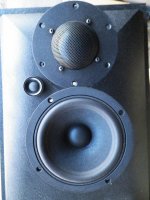 100_0994.jpg582.5 KB · Views: 139
100_0994.jpg582.5 KB · Views: 139 -
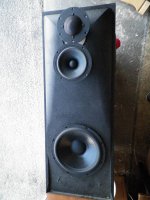 100_0991.jpg644.8 KB · Views: 131
100_0991.jpg644.8 KB · Views: 131 -
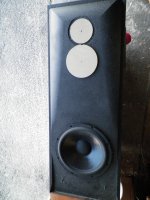 100_0990.jpg685.6 KB · Views: 130
100_0990.jpg685.6 KB · Views: 130 -
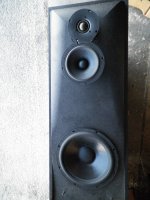 100_0989.jpg627.4 KB · Views: 123
100_0989.jpg627.4 KB · Views: 123 -
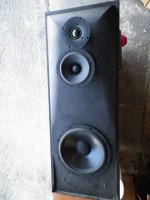 100_0987.jpg615 KB · Views: 124
100_0987.jpg615 KB · Views: 124 -
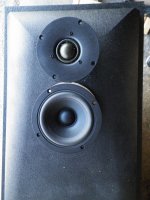 100_0986.jpg704.7 KB · Views: 28
100_0986.jpg704.7 KB · Views: 28 -
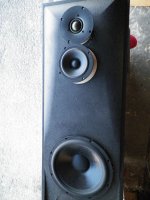 100_0985.jpg635.9 KB · Views: 36
100_0985.jpg635.9 KB · Views: 36 -
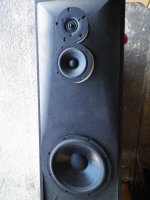 100_0984.jpg649.9 KB · Views: 34
100_0984.jpg649.9 KB · Views: 34 -
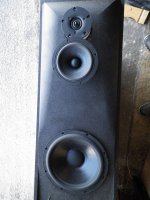 100_0982.jpg650.3 KB · Views: 28
100_0982.jpg650.3 KB · Views: 28 -
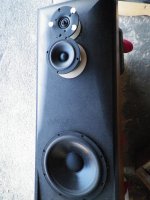 100_0979.jpg627.4 KB · Views: 35
100_0979.jpg627.4 KB · Views: 35
Last edited:
Hi,
Back to square 1.
You want to repurpose empty cabinets, or do they have drivers ?
What size are the mid and tweeter cut outs ?
What volume is the midrange chamber ?
Bass cut out size and bass enclosure volume ?
This is for nearfield, what amplification ? Bi-amping may be easier.
What is the ambition ? budget that does the job well or
better at more cost because you don't wan't to do budget ?
rgds, sreten.
Back to square 1.
You want to repurpose empty cabinets, or do they have drivers ?
What size are the mid and tweeter cut outs ?
What volume is the midrange chamber ?
Bass cut out size and bass enclosure volume ?
This is for nearfield, what amplification ? Bi-amping may be easier.
What is the ambition ? budget that does the job well or
better at more cost because you don't wan't to do budget ?
rgds, sreten.
To aim to flat response at 60¤ laterallywith a regular 3-way? I would say that it is impossible without a dsp - an even then you would have terrible power response.
How about a simple and dirty trick - turn the speaker or make the baffle turned at least 30¤, preferably 45¤
Another trick is to buy/make an omnipole speaker like Duevel/clone
How about a simple and dirty trick - turn the speaker or make the baffle turned at least 30¤, preferably 45¤
Another trick is to buy/make an omnipole speaker like Duevel/clone
An externally hosted image should be here but it was not working when we last tested it.
You want to repurpose empty cabinets, or do they have drivers ?
Yes, they are the cabinets pictured above. They are empty.
What size are the mid and tweeter cut outs ?
I'm modifying them to accept:
Wavecor TW030WA07 30 mm tweeters:
http://solen.ca/pdf/wavecor/TW030WA05_06_07_08.pdf
or
Vifa XT25: http://www.troelsgravesen.dk/PL18XT_files/XT25TG.pdf
and
Wavecor WF120BD04: https://www.solen.ca/pdf/wavecor/WF120BD03_04.pdf
To see off axis response (different cone): http://www.wavecor.com/WF120BD05_06_specifications.pdf
or
Wavecor WF152BD02: https://www.solen.ca/pdf/wavecor/WF152BD01_02.pdf
To see off-axis response (different cone): http://www.ari-acoustics.de/WebRoot.../MediaGallery/WF152BD01_02_specifications.pdf
What volume is the midrange chamber ?
2.7 liters
Bass cut out size and bass enclosure volume ?
Bass is 50 liters (330 cm^2 driver) with perhaps temporary Usher drivers similar to Usher 1001B.
Tuned to 28 Hz I think. I can enlarge the cutout at a later time if I want.
This is for nearfield, what amplification ? Bi-amping may be easier.
It will be run off my computer. 6 channels using KX drivers. Can do anything with any channel I want, more or less. Bass drivers will be somewhat blocked by my bureau/desk lol (don't lol) lol

so . . .
I think it might be best I run the 93 cm^2 woofers as mids so they can go down to 100 Hz comfortably, sacrificing the acoustic centers being further apart and off-axis response. The 50 cm^2 mids sound really detailed and are paper cone instead of the Nomex of the 93 cm^2 mids. I prejudiced against paper and smaller drivers, if I have a choice. Although the small paper cones fast transients and detail are very nice for low SPL listening.
Drivers will be 1 meter and about 50-60 degrees off-axis from my head.
I'm kind of finishing it up rather soon. I thinking of going with the tw030 tweeter and WF152, but I don't know if I can get away with crossing the WF120 at 150-200 Hz. I had a 3-way active hooked up to my computer before and the mids crossed over at 150 Hz did not sound as good as when they were at 100 Hz. It was a similar setup.
Hmmm . . . maybe a picture would help.
After searching for awhile, I can't find a picture of my old speakers.
Last edited:
To aim to flat response at 60¤ laterallywith a regular 3-way? I would say that it is impossible without a dsp - an even then you would have terrible power response.
How about a simple and dirty trick - turn the speaker or make the baffle turned at least 30¤, preferably 45¤
Another trick is to buy/make an omnipole speaker like Duevel/clone
An externally hosted image should be here but it was not working when we last tested it.
Nice "reverse" or "negative" waveguide I was referring to earlier when the "normal" waveguide enthusiast was still commenting lol I kind of miss him lol
Actually two "reverse" waveguides and one "normal" one, with compression driver? Looks like a fun design. I just bought an enclosure because I don't have time to build one from scratch.
I actually thought about build some "reverse wave guides into the metal grills I might put on these.
Also I'm affair the grills will interfere with the off-axis response.
Last edited:
- Status
- This old topic is closed. If you want to reopen this topic, contact a moderator using the "Report Post" button.
- Home
- Loudspeakers
- Multi-Way
- I want to use 4 ohm Vifa XT25 tweeters with 8 ohm amp
